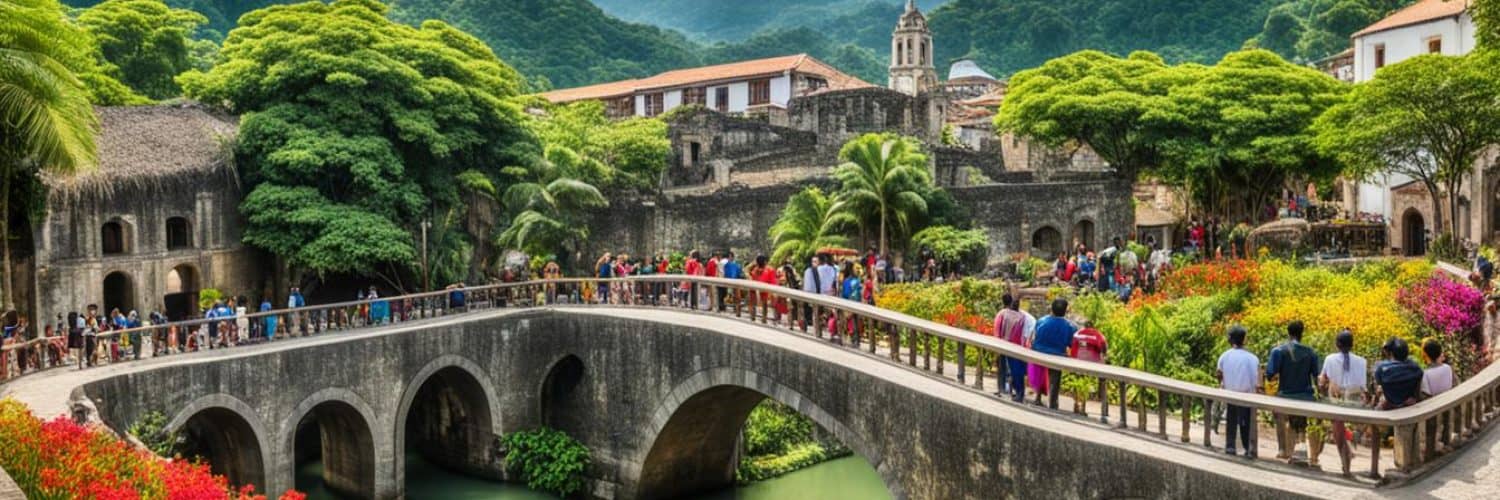Discover the rich cultural heritage and fascinating historical landmarks of Tarangnan in Samar, Philippines. This municipality is a treasure trove for history enthusiasts and tourists alike, with its renowned Tarangnan Historical Sites that offer a glimpse into the region’s vibrant past.
From centuries-old ruins to significant pilgrimage sites, Tarangnan holds a special place in the cultural identity of Samar, Philippines. Immerse yourself in the history and explore the historical landmarks that have shaped the municipality’s unique heritage.
Key Takeaways:
- Tarangnan in Samar, Philippines is home to a rich cultural heritage and numerous historical landmarks.
- Explore the historical sites that attract history enthusiasts and tourists alike.
- Discover the captivating history of Tinago, now known as Dapdap, one of the cradles of Christianity in the Philippines.
- Learn about the transfer of the capital from Dapdap to Tarangnan and its historical significance.
- Visit Tinago Church and its oldest bell in Samar, which predates the historic Balangiga bells of Eastern Samar.
The History of Tinago and Dapdap
Tinago, now known as Dapdap, holds a significant place in the history of Samar, Philippines. It was once the capital of Samar and played a pivotal role in the spread of Christianity in the country. The arrival of Jesuit missionaries in Tinago during the late 1500s transformed it into an important historical pilgrimage site.
Over time, Tinago underwent a name change and became known as Dapdap. Despite this, its historical significance remains evident in the 18th-century church ruins that stand atop a hill. These ruins serve as a testament to the rich heritage and cultural impact of the village, attracting visitors from far and wide.
“Tinago, now Dapdap, bears witness to the rich history of Samar and the profound influence of Jesuit missionaries in the region. The surviving church ruins stand as a reminder of the past, inviting us to explore and appreciate the historical pilgrimage site.”
The Historical Significance of Tinago and Dapdap
When Jesuit missionaries arrived in Tinago, they encountered a village ripe for the spread of Christianity. Their efforts resulted in the establishment of the church and the subsequent religious conversion of the local community. The impact of this historical period can still be felt today through the ruins, which allow visitors to connect with the past and understand the cultural journey of the region.
Rediscovering Tinago Ruins
The Tinago Ruins provide a fascinating glimpse into the historical development of Samar. With its captivating architectural remnants and serene hilltop location, the site creates an atmosphere of reverence and awe. It has become a must-visit destination for history enthusiasts and those seeking a deeper understanding of the region’s past.
| Description | Details |
|---|---|
| Location | Dapdap, Tarangnan municipality, Samar |
| Historical Significance | Crucial role in the spread of Christianity in the Philippines |
| Architectural Features | 18th-century church ruins |
| Accessibility | Reached via a motorboat ride from Tarangnan town proper |
| Visitor Experience | Immersive exploration of the historical site and its surroundings |
Visiting the Tinago Ruins is not merely a journey through history but also an opportunity to appreciate the beauty of the surroundings. The site offers breathtaking views of the landscape, allowing visitors to connect with both the past and the natural splendor of Samar.
Through efforts to preserve and promote Tinago Ruins as a historical pilgrimage site, the local community and tourism stakeholders aim to ensure its continued recognition and appreciation for generations to come.
The Transfer to Tarangnan
In the 1800s, the municipality of Tarangnan faced a significant challenge as a wave of cholera swept through various parts of Samar. This outbreak necessitated the transfer of the capital from Dapdap to Tarangnan. In April 1884, King Alfonso I of Spain approved the petition for the capital’s relocation, marking a pivotal moment in Tarangnan’s history.
The decision to transfer the capital was met with resistance from locals who had deep-rooted attachments to Dapdap. Nonetheless, the image of St. Francis of Assisi, a revered symbol in the region, was transferred to the new capital. This landmark event solidified Tarangnan’s position as the administrative center of Samar, Philippines.
| Key Points | Details |
|---|---|
| Year | 1800s |
| Reason for Transfer | Wave of cholera |
| Approving Authority | King Alfonso I of Spain |
| Capital Relocation | April 1884 |
| Transferred Image | St. Francis of Assisi |
The transfer of the capital to Tarangnan was a pivotal moment in the municipality’s history. It not only marked a response to the challenging wave of cholera but also served as a testament to the resilience and adaptability of the people of Tarangnan. The image of St. Francis of Assisi continues to be an integral part of Tarangnan’s cultural and historical identity.
The Importance of Tinago Church
Tinago Church, located in the village of Dapdap, holds immense historical significance in Samar, Philippines. Built in opposition to the transfer of the image of St. Francis of Assisi, this church stands as a testament to the rich cultural heritage of the region. Despite being unfinished due to financial constraints, Tinago Church houses the oldest bell in Samar, dating back to 1753.
This bell, which predates the historic Balangiga bells of Eastern Samar, is not only a valuable relic but also a symbol of the resilience and spirit of the community. Its presence serves as a link to the past, connecting us to the early days of Christianity in the Philippines. As visitors approach this sacred site, they can’t help but feel the weight of history envelop them.
“Tinago Church stands as a tribute to the determination of the wealthy families in Dapdap who rallied behind the construction of this religious sanctuary.” – Local historian
Although Tinago Church remains unfinished, its architectural remnants and the historical documents it houses offer a glimpse into the past. Exploring this site allows us to appreciate the dedication and vision of those who initiated its construction. It also provides an opportunity to reflect on the influence of Christianity on the identity of Samar, shaping its cultural fabric.
In addition to its historical significance, Tinago Church carries a spiritual presence that resonates with visitors. The tranquil atmosphere invites contemplation and encourages a sense of awe for the faith and devotion that were once intertwined with the very stones that make up this sacred space.
As we continue to preserve and honor the heritage of Tinago Church, we ensure that future generations can experience the power of its history firsthand. The church serves as a reminder of the stories that shaped our communities and the strength found within our collective past.
Efforts to Revive Tourism in Tinago Ruins
Since 1996, significant efforts have been made to revive tourism in Tinago Ruins, coinciding with the quadricentennial celebration of Christianity in Samar. The local government has played a pivotal role in promoting the heritage value of Tinago Ruins and attracting tourists from all over the world.
To enhance the tourism experience, the government has introduced the Ibabao Trail, a scenic route that encompasses Tinago Ruins as one of the prominent attractions. This trail allows visitors to explore the historical significance and architectural beauty of the ruins while immersing themselves in the captivating natural landscapes of Samar.
Moreover, ongoing plans are in place to further develop and preserve the area, with the aim of catering to the growing interest in heritage tourism. These initiatives include the restoration and conservation of Tinago Ruins, ensuring that future generations can appreciate the cultural legacy it represents.
Tinago Ruins is not just an archaeological site; it holds the key to unearthing the intriguing history of Samar. By reviving tourism in this historical gem, the local community and visitors can forge a deeper connection with the past and contribute to the preservation of the region’s rich cultural heritage.
Quotes:
“Tinago Ruins is a testament to our history and cultural identity. By promoting tourism in this area, we are opening avenues for economic growth and safeguarding our heritage for generations to come.” – Mayor Victoria Santos
The Ibabao Trail:
The Ibabao Trail offers a unique opportunity for visitors to immerse themselves in the cultural and natural wonders of Samar. Here are some highlights of the trail:
- Start your journey at Tinago Ruins, where the remnants of the historic church stand as a reminder of the region’s religious significance.
- Continue along the trail to discover the breathtaking beauty of Samar’s landscapes, with lush forests, scenic rivers, and panoramic views.
- Explore the charming local communities along the way, where you can engage with the warm hospitality of the Samar people.
- Visit other historical sites and landmarks, such as Dapdap Church and Balantak Falls, which showcase the diverse cultural and natural heritage of the region.
The Ibabao Trail not only offers a glimpse into the past but also provides an opportunity to support local communities and promote sustainable tourism in Samar.
Potential Economic Benefits
Reviving Tinago Ruins as a pilgrimage site in Tarangnan municipality can have significant economic benefits for the local community. By tapping into the historical and cultural significance of this site, job opportunities can be generated, enhancing the livelihoods of the residents.
Local artisans and craftsmen can play a crucial role in the revival of the Tinago Ruins. They have the potential to produce various religious items that would attract pilgrims and tourists. Products such as intricately crafted rosaries, devotional novenas, and candles can be made, showcasing the unique skills and craftsmanship of the locals.
“The revival of Tinago Ruins can lead to the generation of job opportunities for local artisans and craftsmen, who can produce religious items such as rosaries, novenas, and candles.”
In addition to job generation, tourism can bring about an economic boost to the area. The influx of visitors seeking to explore the historical wonders of Tinago Ruins can drive economic activity in various sectors.
With the rise in tourism, the need for accommodation and dining establishments arises. Local entrepreneurs can seize this opportunity to establish homestays, guesthouses, and restaurants to cater to the needs of visitors.
Furthermore, Tarangnan municipality is known for its beautiful beaches located in close proximity to Tinago Ruins. As tourists visit the pilgrimage site, they may also be encouraged to explore the natural wonders and engage in beach activities, contributing to additional economic growth.
This overall economic development can lead to better infrastructure, improved access to basic services, and an enhanced quality of life for the residents of Tarangnan municipality.
To summarize, the revival of Tinago Ruins has the potential to generate jobs for local artisans and craftsmen, promote the production of religious items, and boost the economy through increased tourism. This economic growth can bring about positive changes to the livelihoods and overall development of Tarangnan municipality.
Accessing Dapdap
Despite improvements in road infrastructure, reaching Dapdap by land can still be challenging, especially if coming from the town of Pagsanghan. The easiest way to reach Dapdap is by motorboat, with a 20-minute ride from Tarangnan town proper. However, there are still unfinished roads that make it difficult to reach the historical site.
“Reaching Dapdap by land can be challenging, especially if coming from the town of Pagsanghan.”
Getting to Dapdap, a historical pilgrimage site, requires navigating through rugged roads and unfinished pathways. While alternative transportation options like motorboats are available, accessing the site by land remains a challenge due to the lack of fully developed roads.
| Transportation Options | Difficulty Level |
|---|---|
| By Land | Challenging |
| By Motorboat | Easier |
Exploring the historical wonders of Dapdap is worth the effort, and visitors can experience the unique charm of this iconic site. However, it is important to plan transportation in advance to ensure a smooth journey to Dapdap.
Tarangnan Municipality Overview
Tarangnan is a municipality located on the western coast of Samar Island in the Eastern Visayas region of the Philippines. It is situated to the southeast of the ancient town of Bangahon (now Gandara) and to the north of Samar’s capital, Catbalogan. The municipality covers a total area of 132.49 square kilometers and has a population of approximately 25,713 people.
Geographical Location
Tarangnan municipality is strategically positioned along the western coast of Samar Island, providing stunning views of the Samar Sea or Maqueda Bay. Its geographical location in the Eastern Visayas region makes it easily accessible by land and sea transportation. The municipality’s proximity to the municipalities of Bangahon and Catbalogan contributes to its cultural and economic significance within the region.
Tarangnan’s geographical location offers a unique blend of natural beauty and historical charm. Visitors can enjoy the pristine beaches and coastal landscapes, as well as explore the historical landmarks that showcase the rich cultural heritage of the municipality.
| Geographical Information | Details |
|---|---|
| Region | Eastern Visayas |
| Province | Samar |
| Island | Samar |
| Coastal Location | Western coast |
| Neighboring Towns | Bangahon (now Gandara), Catbalogan |
Climate and Geography of Tarangnan
Tarangnan, located on the western coast of Samar Island in the Philippines, experiences a pleasant tropical climate. With average daily temperatures ranging from 28 to 31 degrees Celsius, the municipality enjoys warm and balmy weather throughout the year.
Situated along the Samar Sea or Maqueda Bay, Tarangnan benefits from its proximity to the sea. The coastal location brings a refreshing breeze and creates a relaxing atmosphere for locals and visitors alike. The municipality’s western coast offers stunning views of the sea and picturesque sunsets that leave a lasting impression.
Additionally, Tarangnan boasts relatively accessible transportation routes, making it easier for tourists to explore the area. The well-connected road network and proximity to major towns ensure convenient travel to and from Tarangnan. Whether you are heading to the municipality’s historical sites or its beautiful beaches, transportation is readily available.
| Month | Average Temperature (°C) | Rainfall (mm) |
|---|---|---|
| January | 28 | 97 |
| February | 28 | 74 |
| March | 29 | 53 |
| April | 30 | 38 |
| May | 30 | 70 |
| June | 30 | 89 |
| July | 30 | 114 |
| August | 30 | 131 |
| September | 30 | 134 |
| October | 29 | 144 |
| November | 29 | 153 |
| December | 28 | 159 |
Source: Tarangnan Municipal Disaster Risk Reduction and Management Office
Exploring Tarangnan’s Climate
In Tarangnan, you can expect warm and pleasant weather throughout the year. The average temperature of 28 to 31 degrees Celsius provides a comfortable environment for outdoor activities and explorations. Whether you’re visiting historical sites or enjoying the stunning coastal scenery, Tarangnan’s climate sets the perfect backdrop for your adventures.
Barangays of Tarangnan
Tarangnan municipality is composed of 41 unique barangays, each contributing to the cultural and historical richness of the region. These barangays showcase the diverse characteristics and communities that make Tarangnan a vibrant and thriving municipality. Here are some of the notable barangays:
- Alcazar
- Bahay
- Binalayan
- Cabunga-an
- Dapdap
- Poblacion A
These barangays, along with many others, play an integral role in preserving the heritage and traditions of Tarangnan. Each barangay has its own unique identity, contributing to the diverse tapestry of the municipality. The people of Tarangnan take pride in their barangays and work together to foster a sense of community and belonging.
Whether it’s through cultural celebrations, community initiatives, or preserving historical landmarks, the barangays of Tarangnan are the backbone of the municipality, ensuring the preservation of its cultural and historical legacy.
| Barangay | Unique Characteristics |
|---|---|
| Alcazar | Natural landscapes, agricultural activities |
| Bahay | Traditional crafts, local festivals |
| Binalayan | Fishing community, coastal scenery |
| Cabunga-an | Lush greenery, hiking trails |
| Dapdap | Historical landmarks, pilgrimage site |
| Poblacion A | Central hub, bustling markets |
Education and Literacy in Tarangnan
Tarangnan has shown commendable progress in the field of education and literacy. The municipality has taken significant steps to improve access to primary and secondary education, resulting in positive outcomes for the community. Notable developments include the establishment of primary education in select barangays and the expansion of secondary education through institutions like Tarangnan National High School.
The promotion of primary education in specific barangays has played a crucial role in ensuring that children have access to quality education from an early age. This initiative has contributed to the overall improvement in the literacy rate of Tarangnan.
In addition, the expansion of secondary education opportunities, exemplified by the presence of Tarangnan National High School, has further enhanced the educational landscape of the municipality. This ensures that students have the opportunity to continue their studies beyond primary education, equipping them with the necessary skills for their future endeavors.
According to the National Statistics Office (NSO) 1995 survey, Tarangnan recorded an impressive literacy rate of 89.95%. This statistic reflects the municipality’s commitment to fostering a culture of learning and highlights the effectiveness of its educational initiatives.
Conclusion
Tarangnan in Samar, Philippines is a hidden gem for history enthusiasts, offering a unique glimpse into the rich cultural heritage and historical sites of the region. The municipality is home to several remarkable landmarks, including the renowned Tinago Ruins, the historic Dapdap Church, and the charming Tarangnan Town Proper. These sites serve as a testament to the deep-rooted history and cultural identity of the area.
Exploring Tarangnan’s historical sites allows visitors to embark on a captivating journey through the fascinating history of Samar, Philippines. From the remnants of the Tinago Ruins to the spiritual aura of Dapdap Church, each site unveils stories of the past, providing a valuable and enriching experience for all who venture here.
By preserving and promoting these historical gems, Tarangnan not only safeguards its cultural heritage but also offers a gateway for tourists and history enthusiasts to immerse themselves in the captivating narratives of Samar’s past. Whether it’s tracing the footsteps of ancient settlers or unraveling the architectural marvels of centuries-old structures, Tarangnan’s historical sites offer a captivating glimpse into the vibrant tapestry of Samar’s history.
FAQ
What historical landmarks can I explore in Tarangnan, Samar, Philippines?
Tarangnan is home to numerous historical landmarks, including Tinago Ruins, Dapdap Church, and Tarangnan Town Proper.
What is the historical significance of Tinago (now known as Dapdap)?
Tinago (now Dapdap) used to be the capital of Samar and was considered one of the cradles of Christianity in the Philippines, with Jesuit missionaries arriving in the late 1500s.
Why was the capital transferred to Tarangnan?
The transfer of the capital from Dapdap to Tarangnan was due to a wave of cholera that affected various parts of Samar in the 1800s and was approved by King Alfonso I of Spain.
What is the importance of Tinago Church?
Tinago Church, also known as the unfinished church, houses the oldest bell in Samar and is considered older than the historic Balangiga bells of Eastern Samar.
What efforts have been made to revive tourism in Tinago Ruins?
In 1996, during the quadricentennial celebration of Christianity in Samar, efforts were made to revive tourism in Tinago Ruins. The local government introduced the Ibabao Trail, which includes Tinago Ruins as one of the attractions.
What potential economic benefits can tourism bring to Tarangnan?
How can I access Dapdap?
Accessing Dapdap can be challenging by land, especially if coming from the town of Pagsanghan. The easiest way to reach Dapdap is by motorboat, with a 20-minute ride from Tarangnan town proper.
Where is Tarangnan located?
Tarangnan is a municipality located on the western coast of Samar Island in the Eastern Visayas region of the Philippines, southeast of Bangahon (now Gandara) and to the north of Samar’s capital, Catbalogan.
What is the climate and geography of Tarangnan?
Tarangnan experiences a tropical climate, with average daily temperatures ranging from 28 to 31 degrees Celsius. It is located on the western coast of Samar Island and is bordered by the Samar Sea or Maqueda Bay.
How is Tarangnan politically divided?
Tarangnan is politically subdivided into 41 barangays, each with its own unique characteristics and communities.
What is the status of education and literacy in Tarangnan?
Tarangnan has made significant progress in education and literacy, with the opening of primary education in certain barangays and the expansion of secondary education, such as Tarangnan National High School. The literacy rate in Tarangnan was recorded at 89.95% in the NSO 1995 survey.
Why should I explore Tarangnan’s historical sites?
Exploring Tarangnan’s historical sites allows visitors to delve into the fascinating history and cultural heritage of Samar, Philippines, making it a compelling destination for history enthusiasts.


















Add comment